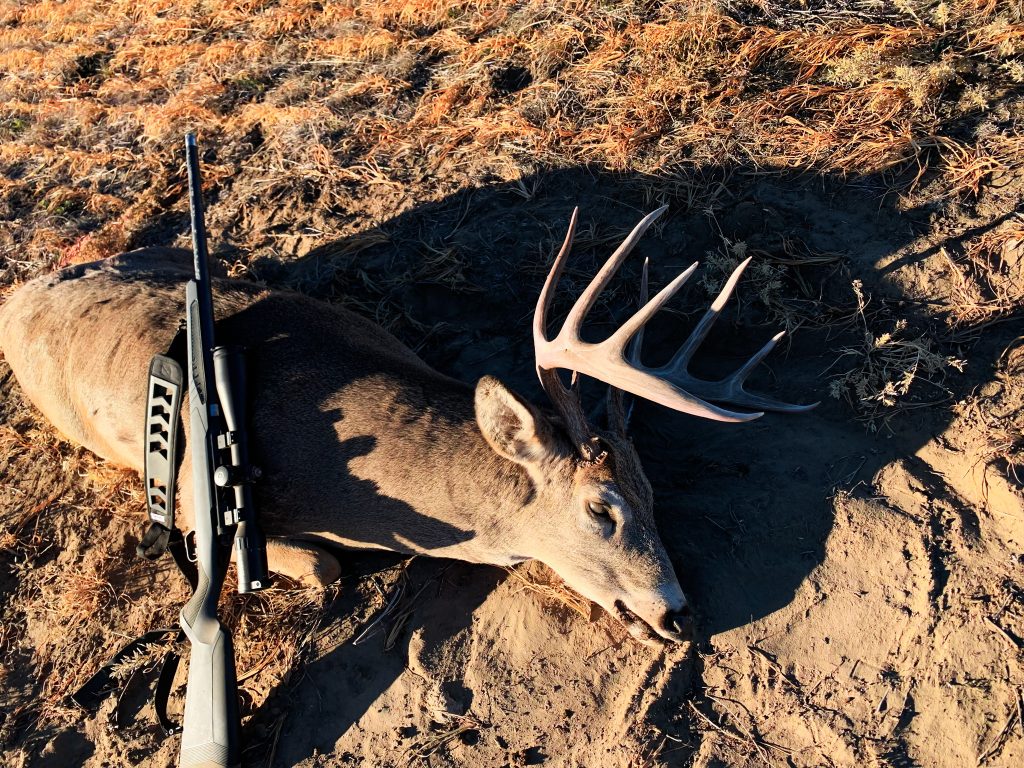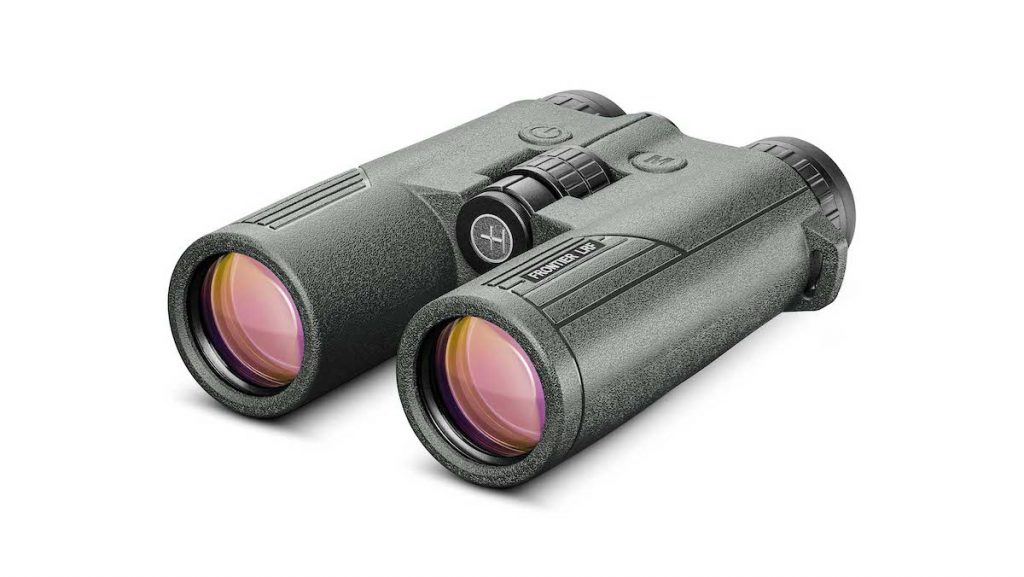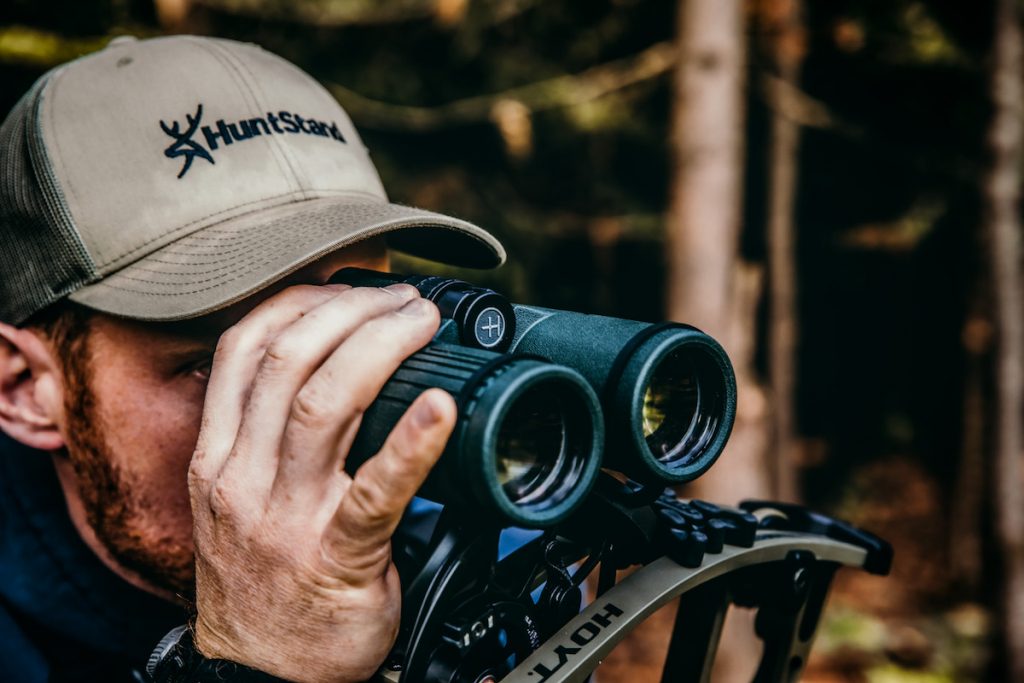Hawke Optics breaks new ground for 2023 with a top-end rangefinding binocular, and according to this review, the new optic is worth its weight in gold.
By Darron McDougal
The shot broke beautifully, but I lost the big 5×5 whitetail amidst my Savage rifle’s recoil. When I worked the rifle’s bolt, the buck, and several other deer he was with disappeared behind a hill in the prairies. I flipped the safety back on and hustled toward a better vantage.
I crested the hill and noticed the herd running across the wide-open prairies. The 5×5 wasn’t in it, and that’s because he’d gone merely 30-40 yards after my bullet pierced his heart. My wife, who was next to me when I shot, joined me. With huge grins and wide eyes, we approached the tremendous public land buck, which was a gift from God.

Though I’d been familiar with Hawke Optics for years, that fall 2021 deer hunt was my first time genuinely putting one of its products through its paces. Hawke’s Endurance 30 WA SF scope gave me nothing but confidence during the intense encounter with that 5×5, and it indeed passed the test when he posed broadside 240 yards away.
It’s no surprise that Hawke’s Paige Shipe got my attention when she unveiled the Frontier LRF 10x42mm rangefinding binocular for my wife and me at a trade show in January. I knew right then and there that I had to try it out. After having it for a few weeks, let me detail why I’ll trust my 2023 hunting season to Hawke’s first rangefinding binocular.

It’s Convenient
Most rangefinders need more magnification for identifying animals, especially out West at longer distances or in diminishing daylight. And with only a binocular, yardage is nothing more than a guess. For years I hunted with both a binocular and a rangefinder. Eventually, I grew tired of the unnecessary cumber and simplified by getting an entry-level rangefinding binocular. It has mainly served its purpose since 2017, but I’ve always coveted a sturdier platform and more precise optics.
Hawke’s Frontier LRF checks those boxes and many more. Features and benefits aside, the reason to carry Hawke’s sweet new rangefinding model is that you get the clarity and magnification of a binocular and the exact yardage calculation of a high-end rangefinder. And, considering the prices of the market’s other range finding binoculars, this one is priced reasonably.
Construction, Comfort, and Clarity
I hunt in many unforgiving places where my equipment will take a hit sooner or later. The Frontier LRF’s magnesium alloy chassis exudes dependability, but it’s reasonably lightweight at 37 ounces — only ounces heavier than a competitor’s rangefinding binocular, which retails for over $4,000.
An ergonomic, non-tacky textured rubber over the chassis provides positive hand traction and absorbs shock. Plus, it doesn’t have a “boot-rubber” odor like my previous rangefinding binocular did. It also wholly encompasses the power and mode buttons to remove dust and debris. The rubber covering is a nice inconspicuous green color that perfectly complements the black eyecups and focus wheel.

The ergonomic rubberized molding provides positive hand traction, and the mode buttons are set for easy access regardless if you’re target shooting or ranging a dream bull in the mountains. Photo by Becca McDougal
The Frontier LRF is nitrogen-purged, waterproof, and fog proof. It features water-repellent lens coatings. In other words, it’s the ideal companion for dogging Roosevelt bulls in northwestern Washington’s rainforests or sitting in an Illinois treestand during a late-October drizzle.
Clarity? The Frontier LRF delivers that, too. This bad boy gives you a crystal-clear, high-definition viewing experience via Hawke’s all-new H7 optical system with high light transmission and a patented prism system with Beam Split Coating. Color control and phase correction are also products of H7 optics, and the lenses are fully multi-coated. I tested the Frontier in varying conditions, from full sunlight to dusky, overcast lighting, and the color, clarity, contrast, and brightness are exceptional.

A magnesium alloy chassis is lightweight yet ultra-durable, and it’s protected by an inconspicuous green molding to absorb the bumps and drops common with hardcore hunting. (Photo by Becca McDougal)
Options and Accuracy
The Frontier LRF has +/- 1-yard accuracy out to 2,515 yards and can range targets as close as 11 yards. When the rangefinder is powered on, you can alternate to meters by holding the mode button for about 2 seconds. The meter range has +/- 1-meter accuracy out to 2,300 meters and can range as close as 10 meters.
This is where things get very interesting. The Frontier LRF has six different ranging modes that include Standard, Rain, Hunt, Near, Horizontal Distance, and Angle. In other words, it can be optimized instantly for any specific hunting application at the click of the mode button. Using and understanding the settings doesn’t require a college degree, either. It’s a super user-friendly system.
I used the Frontier LRF outdoors but also through my office window (through the glass) and a window screen. It ranged through both without a problem. I was surprised that the mesh window screen didn’t inhibit its capabilities. When ranging larger targets beyond branches, I found that it read the limbs in the standard mode, but it ranged my intended target beyond the limbs when I set it in both the Hunt and Rain modes. It even ranged my target when obstructed by branches with leaves. I was very impressed.
I’ve owned multiple rangefinders because of my vocation. I’ve seen the difference in having an illuminated readout. A non-illuminated black readout is too difficult to see in low-light conditions. The Frontier is rigged with a red-colored OLED display that’s easy to see and has six brightness levels. Full brightness is ideal in broad daylight and doesn’t inhibit your view of the target or animal. But, as dusk envelopes the landscape, it helps to dial the brightness back so that you can see both the range readout and the animal. Brilliant.
Finish Line
Feature-wise, I want to mention one more thing. The Frontier LRF Auto Shut-Off Battery-Save feature prolongs the CR2 battery’s life. After 15 seconds of inactivity, the electronics automatically turn off to conserve power. The OLED display also has a low-battery indicator, so you know when to replace the battery.
Hawke includes several extras. Inside the box, I found an instruction manual, CR2 battery, lens cloth, protective pouch, protective carry case and strap, neck strap, objective lens, and ocular lens covers. I tested out the protective carry case, which is similar to the bino pouches you see every YouTuber wearing on Western hunts.

Hawke includes a protective carry case, which will protect your investment in transit. But, you can add the included harness and wear the case afield to protect your Frontier LRF from rain and dust as you hunt. (Photo by Becca McDougal)
I’d suggest upgrading to a quieter, heavier-duty option, such as Sitka’s Mountain Optics Harness for bowhunting. If I were strictly a gun hunter, I’d probably just stick with this one, as it works fine and is plenty comfortable.
If you prefer less magnification, Hawke offers the Frontier LRF in an 8x42mm option. Its range is slightly less, but it still reaches 1,968 yards. It weighs a smidge less at 35.2 ounces, and it’s half an inch shorter. Its MSRP is $1,329, while the 10×42 mm’s MSRP is $1,439.
Hawke backs the Frontier LRF with its No-Fault Lifetime Warranty (2-year warranty on electronics). That, combined with the feature-driven performance I detailed above, is why Hawke’s first-ever rangefinding binocular is worth every penny. It’s also why it’ll hang on my chest as I pursue antelope, mule deer, and whitetails this fall across several states.




